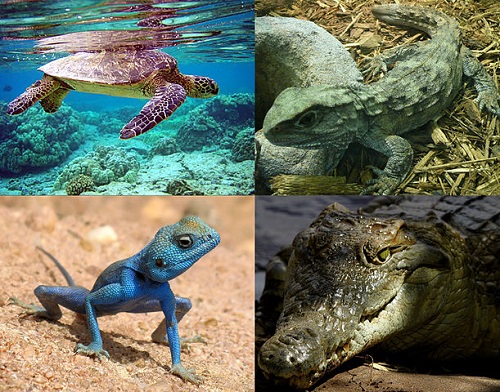Difference Between Reptiles and Mammals
Reptiles and Mammals are two important classes of the phylum chordata. Reptiles were the first true terrestrial chordates. Unlike their predecessors, their bodies and the shells of their eggs were well adapted to withstand desiccation and they did not have the obligation to live close to water to ensure successful reproduction. Another special feature of Reptiles is that a sub-class (1) of mammal like reptiles called the Synapsids are the ancestors of the present day mammals. In course of their divergent evolution from Reptiles, Mammals developed several features that the reptiles do not possess and turned out to be the most evolved class of animals. The following are some of the differences between Reptiles and Mammals.
External Morphology:
- The general posture of both Reptiles and Mammals is horizontal, except for some of the Primates; the appendages originate laterally for the reptiles while they originate from beneath the body in Mammals (2).
- In Reptiles, the skin is covered by scales while in mammals it is covered with hair or fur and sebaceous glands
Anatomy:
1. Osteology:
- Skull in reptiles is smaller, in proportion to their body, when compared to that of mammals. The smaller skull represents smaller brain and brain body size ratio is roughly used as an indicator of the level of intelligence in animals(3). Thus the size of skull of Mammals signifies their level of intelligence.
- The jaw in reptiles is made up of Quadrate and articulate bones as opposed to jaw made up of a single bone called the dentary in mammals.
- The rounded projections on the posterior of the skull that attach with the first vertebra are called the occipital condyles. There are two such projections in Mammals while the Reptiles possess one.
- The middle ear in in Reptiles it is made up of a single bone called the columella. However in Mammals it is made up of three bones i.e., Malleus Incus and stapes. Of these stapes is homologous to columella of the formerly mentioned class.
- Reptiles lack a fully developed secondary palate, which is a characteristic feature of Mammals. This enables the mammals to facilitate breathing while swallowing; a privilege that Reptiles lack. Crocodiles are an exception.
- Ribs arise from all the vertebrae in Reptiles. However there are variations among them. These may form the carapace and plastron as in turtles(external) or may be limited to the trunk as in snakes snakes. In Mammals, this is limited to the thoracic vertebrae and ribs never form an external case. Caudal ribs are completely absent.
2. Teeth:
- Teeth are continuously replaced in Reptiles (Polyphyodont). However they are produced only twice in the lifetime (Diphyodont) in Mammals.
3. Circulatory System:
- As opposed to a four chambered heart in Mammals, Reptiles have a three chambered heart, with an exception of crocodiles. Although two auricles are present in them, the septum separating the ventricles is incompletely developed.
4. Respiratory System:
- Both Mammals and Reptiles breathe through lungs. However some aquatic species of the latter use skin and cloaca additionally to exchange gases
- Diaphragm facilitates extra room for the lungs to expand during respiration. This structure is lacking in the Reptiles. Crocodiles are an exception to this.
5. Metabolism:
- Reptiles are ectothermic and poikilothermic animals. Their ability to control their body temperatures is limited, which makes their habitat restricted to places where the temperature is usually constant. However Mammals are endothermic and homeothermic with an exception of Heterocephalus glaber. This gives them the advantage to explore various environments.
- As a result of this nature Enzymes are active at a wide range of temperatures in reptiles.
- Compared to Mammals Reptiles have a very low metabolic rate.
6. Nervous System:
- Mammals have a larger and more convoluted cerebrum compared to the reptiles. This signifies higher level of cognitive abilities in th former class of animals
7. Reproduction:
- Mammals are viviparous, i.e., they give birth to individual animals, while Reptiles are Oviparous (egg laying) animals. There are, however, exceptions of lizards like Zootoca vivipara which are viviparous.
- The young ones in reptiles are capable of fending for themselves as soon as they are born (4). Parental care is uncommon. However the mammalian infants are dependent for food on the parent. Nursing of the young ones with mammary glands is the most unique feature of mammals.
- Autotomy and regeneration is common among the lizards.
- Parthenogenesis: The process of reproduction without fertilization of egg (asexually) is called parthenogenesis. This phenomenon is widely reported among several reptilian species. However this has not been reported in mammals.
- Difference Between Vascular and Nonvascular Plants - December 25, 2015
- Difference Between Reptiles and Mammals - November 16, 2015
- Difference Between Gametophytes And Sporophytes - November 9, 2015
Search DifferenceBetween.net :
Leave a Response
References :
[0]http://doc.rero.ch/record/200124/files/PAL_E3902.pdf
[1]http://www.austincc.edu/sziser/Biol%201413/1413%20handouts/reptile%20vs%20mammals.pdf
[2]http://ircamera.as.arizona.edu/NatSci102/NatSci102/lectures/intelligence.htm
[3]https://en.wikipedia.org/wiki/Reptile

